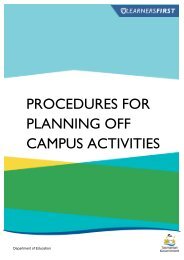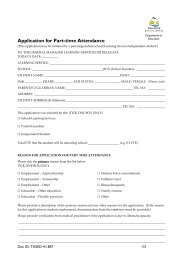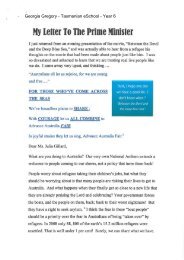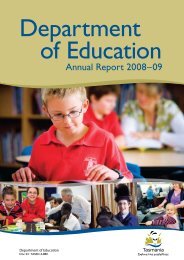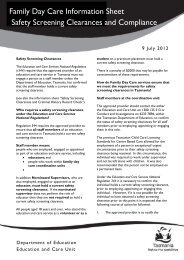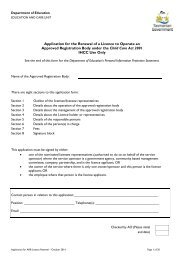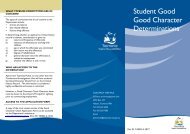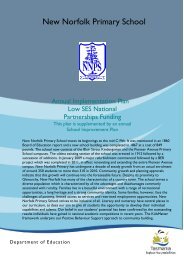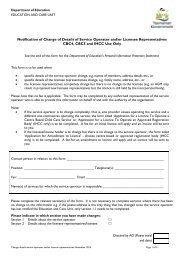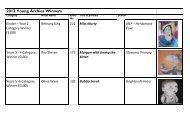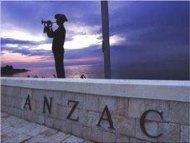Department of Education
DoE Annual Report 2010-2011 - Department of Education
DoE Annual Report 2010-2011 - Department of Education
- No tags were found...
Create successful ePaper yourself
Turn your PDF publications into a flip-book with our unique Google optimized e-Paper software.
2.13<br />
Assets<br />
Assets are recognised in the Statement <strong>of</strong> Financial<br />
Position where it is probable that the future economic<br />
benefits will flow to the department and the asset has a<br />
cost or a value that can be measured reliably.<br />
a) Cash and deposits<br />
Cash means notes, coins and deposits held at call with<br />
a bank or financial institution, for the department and<br />
schools, as well as funds held in the Special Deposits<br />
and Trust Fund. Deposits are recognised at amortised<br />
cost being their face value.<br />
b) Receivables<br />
Receivables are recognised at amortised cost, less<br />
any impairment losses, however, due to the short<br />
settlement period, receivables are not discounted back<br />
to their present value.<br />
c) Assets held for sale<br />
Assets held for sale (or disposal groups compromising<br />
assets and liabilities) that are expected to be recovered<br />
primarily through sale rather than continuing use<br />
are classified as held for sale. Immediately before<br />
classification as held for sale, the assets (or components<br />
<strong>of</strong> a disposal group) are remeasured in accordance with<br />
the department’s accounting policies. Thereafter the<br />
assets (or disposal group) are measured at the lower <strong>of</strong><br />
carrying amount and fair value less costs to sell.<br />
d) Property, plant, equipment, infrastructure,<br />
library book stock and heritage<br />
(i) Valuation basis<br />
Land, buildings, infrastructure, and heritage assets<br />
and other long-lived assets are recorded at fair value<br />
less accumulated depreciation. All other non-current<br />
physical assets, including work in progress, are recorded<br />
at historic cost less accumulated depreciation and<br />
accumulated impairment losses.<br />
In determining the fair value <strong>of</strong> land reference is made<br />
to the best available market evidence <strong>of</strong> the price <strong>of</strong> the<br />
same or similar asset, evidence is drawn from sale <strong>of</strong><br />
nearby land where available.<br />
In determining the fair value <strong>of</strong> buildings and<br />
infrastructure assets a determination is made whether<br />
the asset is <strong>of</strong> a specialised nature or openly traded<br />
in the market. The majority <strong>of</strong> the department’s<br />
building and infrastructure assets are <strong>of</strong> a specialised<br />
nature, i.e. school buildings. The fair value <strong>of</strong> the<br />
department’s specialised buildings and infrastructure<br />
is estimated by the sum <strong>of</strong> current market prices for<br />
one or more transactions required to reproduce or<br />
replace the assets with the modern equivalent, less<br />
accumulated depreciation. As part <strong>of</strong> calculating an<br />
asset’s depreciation a ‘utility’ factor has been applied<br />
which factors in the current spare capacity. For nonspecialised<br />
building and infrastructure assets the fair<br />
value is derived from market evidence on a direct<br />
comparison basis.<br />
Heritage assets with an intrinsic value are valued with<br />
reference to sales <strong>of</strong> identical or similar assets, evidenced<br />
in an open and transparent market place. Assets for<br />
which a buying price is readily accessible are valued at<br />
this replacement cost.<br />
All other non-current physical assets, including work in<br />
progress, are recorded at historic cost less accumulated<br />
depreciation and accumulated impairment losses.<br />
Cost includes expenditure that is directly attributable to<br />
the acquisition <strong>of</strong> the asset. The costs <strong>of</strong> self-constructed<br />
assets includes the cost <strong>of</strong> materials and direct labour,<br />
any other costs directly attributable to bringing the asset<br />
to a working condition for its intended use, and the costs<br />
<strong>of</strong> dismantling and removing the items and restoring the<br />
site on which they are located. Purchased s<strong>of</strong>tware that<br />
is integral to the functionability <strong>of</strong> the related equipment<br />
is capitalised as part <strong>of</strong> that equipment.<br />
When parts <strong>of</strong> an item <strong>of</strong> property, plant and equipment<br />
have different useful lives, they are accounted for as<br />
separate items (major components) <strong>of</strong> property, plant<br />
and equipment.<br />
(ii) Subsequent costs<br />
The cost <strong>of</strong> replacing part <strong>of</strong> an item <strong>of</strong> property, plant<br />
and equipment is recognised in the carrying amount <strong>of</strong><br />
the item if it is probable that future economic benefits<br />
embodied within the part will flow to the department<br />
and its costs can be measured reliably. The carrying<br />
amount <strong>of</strong> the replaced part is derecognised. The costs<br />
<strong>of</strong> day-to-day servicing <strong>of</strong> property, plant and equipment<br />
are recognised in pr<strong>of</strong>it or loss as incurred.<br />
(iii) Asset recognition threshold<br />
The asset capitalisation threshold adopted by the<br />
department is $150,000 for intangible assets and major<br />
capital works, and $10,000 for all other assets. Assets<br />
valued at less than these thresholds are charged to the<br />
Statement <strong>of</strong> Comprehensive Income in the year <strong>of</strong><br />
purchase (other than where they form part <strong>of</strong> a group <strong>of</strong><br />
similar items which are material in total).<br />
(iv) Revaluations<br />
The department revalues applicable assets on a program<br />
<strong>of</strong> five years. In accordance, with AASB 116 Property,<br />
Plant and Equipment, in years between valuations, indices<br />
supplied by qualified valuers are used to establish fair<br />
value.<br />
Assets are grouped on the basis <strong>of</strong> having a similar<br />
nature or function in the operations <strong>of</strong> the department.<br />
e) Other assets<br />
The department recognises some other small assets<br />
such as prepayments <strong>of</strong> expenditure and GST input tax<br />
credits received.<br />
Financial Statements – Notes<br />
99



